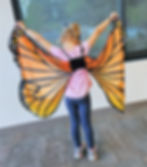A Day Focused on Restoring Biodiversity in our Own Greenspaces
- ljmarkson
- Sep 11, 2023
- 3 min read
At the recent Georgia Audubon’s cleverly named Georgia Grows Native for Birds Round Robin: Transforming Your Greenspace, they partnered with mission aligned Trees Atlanta and the Georgia Native Plant Society for a day of learning from presenters who spoke about making our outdoor spaces a healthier habitat for birds and other wildlife.

The event was held at Trees Atlanta's gorgeous eco-friendly space where exhibitors were on hand to give tools for creating a safer world for wildlife. It was encouraging to meet two cutting edge vendors who remove invasives; Woods Keeper, a business that removes invasives by hand; and ReForest Atlanta, an ecological restoration company offering invasive removal, design & installation, and educational services. No habitat event would be complete without native plants - I chatted with Pandra Williams of the popular Beech Hollow Wildflower Farms native plant nursery and reconnected with Tricia Neal who is opening a new native plant nursery in October called Wild Roots Native Nursery.

The event started off with a Carol Hight from the GNPS West Georgia Chapter giving some basic information about propagating native plants from seed. Alex LoCastro, the Conservation Program Coordiinator from Georgia Audubon followed by sharing a template they created for pollinator and bird-friendly habitats including why pollination is important, why use native plants, what birds and insects need for habitat, keystone plants for supporting the greatest number of caterpillars, and the importance of diversity when designing habitat for birds. Diversity includes the number, kind, blooming and fruiting period of native plants plus a variety of dead plant matter such as leaving the leaves and brush piles.

Madison Cummisky, the Forest Restoration Supervisor from Trees Atlanta shared some eye-popping information about invasive plants in Georgia. I’m still not sure I heard her right, but a graph she showed indicated over 90% of our natural areas in Northeast Georgia are invaded by invasives, meaning you will find invasives every time you go to a natural area! The other stunning fact is that all the invasives in Georgia originated from the exotic ornamental nursery trade. They were intentionally brought and planted here but escaped cultivation. Madison highlighted the invasive plants in Georgia destroying our natural areas that are still sold at nurseries as landscape plants including winter creeper, English ivy, privet, nandina, Chinese holly, liriope, and mondo grass. (Alex also touched on this reality.) It’s encouraging to see folks raising awareness about this ridiculous inconsistency. The trend to outlaw selling invasive plants is growing. It would be great to see more robust advocacy from respected organizations like these partnering with the vocal environmentally aligned groups to end this practice. Change takes strategy and time so hopefully there is behind the scenes work being done around this issue.

Gabe Andrle, the Habitat Program Manager from Georgia Audubon wrapped up the day with compelling stories from a bird’s perspective about the perils for wildlife around maneuvering an increasingly hostile environment. He included a story about a rare warbler who finds refuge when migrating through Georgia in a half-acre Athens sanctuary yard; a hummingbird who maneuvered crossing the country yet lost his life to a bird strike (including the fact that hummingbirds have a disproportionately high vulnerability to window strikes); and a mockingbird who struggles to find insects in a sterile, lawncentric neighborhood. Gabe offered hope by explaining how each of us can create a safe space for wildlife where we live, no matter how small.

All three organizations touched on explaining the yard habitat certifications they offer. I already have certification from two and just earned Trees Atlanta’s City Forest Certification. Since the event was in the Trees Atlanta building the most unexpectedly exciting part of my day was arranging with the coordinator of this program to get my yard sign. I’m honored to have earned this certification because the certification is new, and so far, less than two dozen residential properties have been certified. The program is so popular that there's a bit of a wait to start the process until more volunteers are trained as certifiers. The first thing I did when I came home from the event was post the sign in my front yard to share with my neighbors how we can do our part to contribute to the ecological health of Atlanta.

My takeaway from the day is habitat destruction in multiple forms is contributing to the ecological crisis affecting birds and wildlife and the fix is restoring habitat and biodiversity - even in the smallest greenspaces. For birds, a start is to add keystone native plants, not using pesticides, offering water sources, ensuring we have cover and nesting places, turning off lights at night, preventing window strikes, and sharing nature with children.

Note: There are no affiliate links in this blog. Please click the highlighted text throughout the post for links to references, details, explanations, worthy organizations or businesses, or examples that I think might be helpful.


.jpg)
